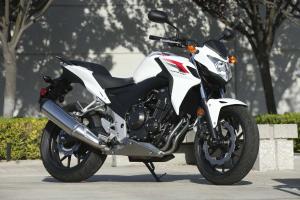2013 Honda CB500F and CBR500R Review - First Ride - Motorcycle.com
As the average age of motorcyclists rises, the industry is scrambling to find a way to attract new riders to the street. How do you turn curious bystanders into devoted consumers?
Honda thinks it has the answer. In addition to the recent launch of the new shift-free CTX700s, Honda has now pulled the wraps off of two of its new trio of 500cc middleweight motorcycles: the naked CB500F and the sporty CBR500R. The adventurish CB500X is dragging its tail over from Japan; expect it by summer.
The CB500s fill a mid-size chasm in an industry too long enamored of flash, power and dash, hoping to strike it rich with high-dollar product rather than build a customer base using reliable and fun transportation that’s also economical and attractive. Those elements are all hallmarks of the Honda brand, so these new entry-level motorcycles should strike a chord with an eco-minded younger generation that’s also image-aware and price-conscious.
ECONOMICAL: Affordable Riding in the New Year
It’s been a while since the industry has seen a new midsize standard. Starting at $5499, the 2013 CB500F is determined to retake the crown of a segment that its namesake ancestor dominated in the 70s but in the last decade or so had relinquished to the Suzuki S(F)V650.
The CBR500R earns its “R” thanks mainly to the racy fairing and clip-on handlebars. It won’t compete with sportbikes in the 600cc class – but then, it’s not in their powerband and it’s nowhere near their price range. At $5999, the R is an ideal step up from the entry-level CBR250. After Kawasaki shook up the entry-level sportbike class with this year’s Ninja 300, a lot of people wondered how Honda would respond.
Heck, at a price point this hot, Honda’s retort has been heard loud and clear.
Two distinct motorcycles, two distinct target audiences. So what do they have in common?
The cylinder head design also incorporates roller rocker arms for a more compact layout along with reduced friction. The compression ratio is 10.7:1. These bikes redline at 8600 rpm before a rev limiter cuts in at 9100 rpm.
ANOTHER OPTION: 2014 CTX700 Review
The 180-degree crankpin design and an engine counterbalancer help smooth operation, and Honda’s Programmed Fuel Injection (PGM-FI) system delivers the appropriate fuel mixture. A pair of 34mm throttle bodies feed the engine, with the injectors located within the throttle-body assembly.
As for the chassis, the engine hangs as a stressed frame member. The result is a diamond-shaped frame with a 35mm steel tube main member that Honda claims is significantly lighter than comparable designs.
What else do these siblings share? The CBR500R and CB500F share the same wheelbase of 55.5 inches. Steering rake is 25° 5', and the front suspension yields 4.3 inches of fork travel. Both share the same Pro-Link single-shock rear suspension system, which offers nine-step cam-style spring preload adjustability and 4.7 inches of travel. They also share a 4.1 gallon fuel tank, and an estimated 71 MPG rating.
ABS is a $500 option on the CBs, and there are more interesting bits about the system on display here. It’s a fully mechanical design, adding just four pounds, and it’s not linked front to rear like most of Honda’s previous ABS systems.
These bikes also share a host of finishing touches many bikes in this price range forego, such as rear passenger grab handles, halogen headlights and tinted LCD instrumentation that features a digital speedometer and tachometer, clock, odometer, tripmeter, and real-time and average fuel consumption meters. Oddly for a modern entry-level bike, there is no gear-position indicator.
Available accessories include a 35-liter rear trunk, saddlebags, saddlebag stay, saddlebag panel (paint-matching), rear carrier, seat cowl, a tank bag, and full host of carbon-style bodywork including front fender, inner cowl, headlight cover, and more.
It should be pointed out the adventure-styled CB500X shares many, many of the same qualities and components as these bikes; that all three bikes share a platform is the foundation on which the entire line is predicated. Look for our full review of that bike judged on its own merits.
So with all that in common, how do these two bikes differ? Aesthetically. Obviously, the fairing sets them apart, and the dual vs. single headlamp. But that’s about it. On the road they feel remarkably indistinguishable; the F has a 49mm higher and 40mm wider handlebar, and on the R that’s “handlebars” – they’re clip-ons. So that’s different. If the R’s fairing deflected more wind around me, I couldn’t actively tell. Oh, and the rear view mirrors – the R’s are angular and sporty, while the F’s are rectangular and plain but serviceable. Beyond that, these two bikes are so incredibly similar you’d think they were twins.
COMPARE: Beginner Sportbike Shootout
That’s not to say it’s not a fun ride – quite the contrary. We didn’t get a ton of seat time, but unlike the bikes I wrote about in our recent Beginner’s Sportbike Shootout, at no time did I feel I brought either bike to its maximum level of performance, and at no time did either bike give an inkling of being wrung out.
Flickable, amenable and good-natured, with plenty of power for the freeway and more than enough maneuverability for the streets, Honda’s new CB500 line seems like the ideal motorcycle for its times.
Related Reading
Beginner Sportbike Shootout
10 Hottest Bikes of 2013
Affordable Riding in the New Year
2014 CTX700 Review
2011 CB1100R Review
More by Jon Langston




































Comments
Join the conversation